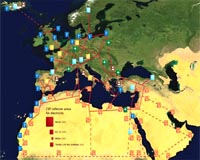 |
College Park MD (SPX) Jul 07, 2010 Using a unique hybrid nanostructure, University of Maryland researchers have shown a new type of light-matter interaction and also demonstrated the first full quantum control of qubit spin within very tiny colloidal nanostructures (a few nanometers), thus taking a key step forward in efforts to create a quantum computer. Published in the July 1 issue of Nature, their research builds on work by the same Maryland research team published in March in the journal Science. According to the authors and outside experts, the new findings further advance the promise these new nanostructures hold for quantum computing and for new, more efficient, energy generation technologies (such as photovoltaic cells), as well as for other technologies that are based on light-matter interactions like biomarkers. "The real breakthrough is that we use a new technology from materials science to 'shed light' on light-matter interactions and related quantum science in ways that we believe will have important applications in many areas, particularly energy conversion and storage and quantum computing," said lead researcher Min Ouyang, an assistant professor in the department of physics and in the university's Maryland NanoCenter. "In fact, our team already is applying our new understanding of nanoscale light-matter interactions and advancement of precise control of nanostructures to the development of a new type of photovoltaic cell that we expect to be significantly more efficient at converting light to electricity than are current cells." Ouyang and the other members of the University of Maryland team - research scientist Jiatao Zhang, and students Kwan Lee and Yun Tang - have created a patent-pending process that uses chemical thermodynamics to produce, in solution, a broad range of different combination materials, each with a shell of structurally perfect mono-crystal semiconductor around a metal core. In the research published in this week's Nature, the researchers used hybrid metal/semiconductor nanostructures developed through this process to experimentally demonstrate "tunable resonant coupling" between a plasmon (from metal core) and an exciton (from semiconductor shell), with a resulting enhancement of the Optical Stark Effect. This effect was discovered some 60 years ago in studies of the interaction between light and atoms that showed light can be applied to modify atomic quantum states.
Nanostructures, Large Advances "The research led Min Ouyang shows that a novel heteronanostructure with the semiconductor surrounding the metallic nanoantenna can achieve the same goals. Such structures are very simple and much easier to make than previously attempted, greatly opening up possibilities for application. Most importantly, they have demonstrated that the light/matter coupling can be manipulated to achieve coherent quantum control of the semiconductor nanoemitters, a key requirement for quantum information processing," said Bryant, who is not involved with this research. Bryant also is a scientist in the Joint Quantum Institute, a leading center of quantum science research that is a partnership between NIST and the University of Maryland. Ouyang and his colleagues agree that their new findings were made possible by their crystal-metal hybrid nanostructures, which offer a number of benefits over the epitaxial structures used for previous work. Epitaxy has been the principle way to create single crystal semiconductors and related devices. The new research highlights the new capabilities of these UM nanostructures, made with a process that avoids two key constraints of epitaxy - a limit on deposition semiconductor layer thickness and a rigid requirement for "lattice matching." The Maryland scientists note that, in addition to the enhanced capabilities of their hybrid nanostructures, the method for producing them doesn't require a clean room facility and the materials don't have to be formed in a vacuum, the way those made by conventional epitaxy do. "Thus it also would be much simpler and cheaper for companies to mass produce products based on our hybrid nanostructures," Ouyang said.
Share This Article With Planet Earth
Related Links University of Maryland Powering The World in the 21st Century at Energy-Daily.com
 Firms plan green energy power lines under Med
Firms plan green energy power lines under MedParis (AFP) July 5, 2010 An industrial consortium launched preparations on Monday for a possible future power grid under the Mediterranean that would carry solar energy from Africa to Europe. The Transgreen group hopes that solar power farms planned in the Sahara desert will generate 20 gigawatts of electricity by 2020, and that a quarter of this could be fed into the European market. For this to happen, underse ... read more |
|
| The content herein, unless otherwise known to be public domain, are Copyright 1995-2010 - SpaceDaily. AFP and UPI Wire Stories are copyright Agence France-Presse and United Press International. ESA Portal Reports are copyright European Space Agency. All NASA sourced material is public domain. Additional copyrights may apply in whole or part to other bona fide parties. Advertising does not imply endorsement,agreement or approval of any opinions, statements or information provided by SpaceDaily on any Web page published or hosted by SpaceDaily. Privacy Statement |